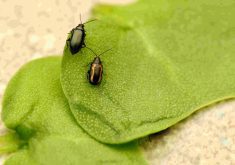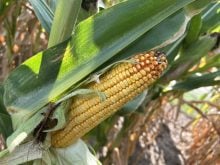There’s a new flea beetle in town, at least according to some datasets.
University of Manitoba entomologist Tharshi Nagalingam says striped flea beetles are on the rise in the province, something that may impact farmer choices on early management.
“It affects them a lot because striped flea beetles are less susceptible for seed treatments… we might need an alternate option, and alternate seed treatment, to kill the flea beetles effectively,” she said, adding that scouting practices may also need review.
Nagalingam pointed to new, as of yet unpublished, data from the University of Manitoba’s Alejandrao Costamagna, which suggests that striped flea beetles may be drawing equal to the more historically prevalent crucifer beetle in Manitoba fields.
Read Also

How much nitrogen can farmers really cut?
Manitoba fertilizer trials look for nitrification inhibitor sweet spot, to lower greenhouse gas emissions and cost without hurting yield.
That data reported 49 per cent crucifer and 51 per cent striped flea beetles in sampled fields as part of a study of four regions across Western Canada.
Manitoba Agriculture’s John Gavloski was more cautious. The provincial entomology expert agreed that there has likely been a rise in striped flea beetles compared to other species, but argued that the problem is actually much more pronounced to the west than in Manitoba.
“It varies from the region quite a bit and on a time of year, even,” he said. “Southern Manitoba, crucifer flea beetle is still the dominant flea beetle, so it’s not like there’s been a total reversal at all.”
So named for the lighter streaks on its back, striped flea beetles emerge sooner than crucifer flea beetles, although after the native hop flea beetle. On average, that timing grants striped flea beetles a one- to four-week head start over their later-emerging cousin.
“What we’re noticing is that early in the season — mid-April and until about the second, third week of May — it’s almost dominantly striped, which has always really been the case,” Gavloski said.
As well as early emergence, Nagalingam also noted the typically high egg counts laid by the crucifer species.
Gavloski pointed to results of a widespread flea beetle population study, funded by provincial and national canola groups and AAFC, and which he contributed to.
Data gathered between 2007-11 throughout Western Canada found that 76 per cent of the beetles in western Manitoba (the aspen parkland eco-region and northwest of Lake Manitoba) were crucifer. The species also predominated on the Lake Manitoba Plain to the east. At the same time, the paper found a higher proportion of striped flea beetles across Manitoba and central Saskatchewan compared to similar counts in the ’70s.
Meanwhile, to the west, striped flea beetles had displaced other species as the dominant beetle in some parts of Alberta.
“The Peace River area of Alberta, it’s almost dominantly striped. Southern Alberta, it’s almost dominantly crucifer,” Gavloski said. “Saskatchewan, it’s a real mixture of the two, but there was a huge survey across the Prairies and they noticed that, overall, there is an increase in striped.”
Four sites on the Lake Manitoba Plain also reported occasional high levels of striped flea beetle, including a 2009 count in Teulon where 55 per cent of the beetles caught were that species. Those spikes, plus “increased likelihood of occurrence of P. striolata (striped flea beetle) there suggests flea beetle population proportions may be changing in this region also,” the researchers reported.
Where are the beetles and what kind are they?
The University of Manitoba is at work on a prediction model to track flea beetle species across the Prairies. The eventual model will add in three years of university data along with varietal information, planting date and other farm variables.
Nagalingam did not have a concrete timeline for when the model might be released to farmers, saying only that the university has partnered with a private firm for the project and that the end result will hopefully be launched by the end of the year.
















